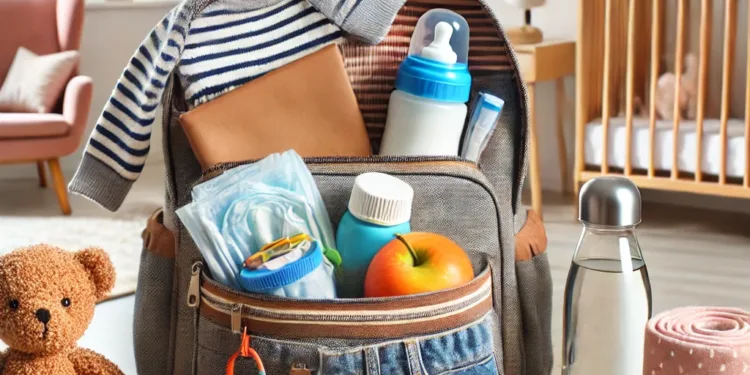The first day at daycare is a significant milestone for both parents and children. It’s an exciting yet challenging transition that requires careful preparation. Ensuring that your child has everything they need for a smooth and enjoyable experience is crucial. This guide will cover the essential items to pack, tips for organization, and considerations to make the day as stress-free as possible for everyone involved.
Essential Items to Pack
1. Clothing and Comfort
- Extra Clothing: Pack at least two extra sets of clothing for your child. This includes shirts, pants, underwear, and socks. Accidents, spills, and messes are common, so having extra clothes ensures your child stays clean and comfortable.
- Weather-Appropriate Clothing: Depending on the season, include weather-appropriate clothing such as a warm jacket, hat, and gloves for winter, or a sun hat and lightweight clothing for summer. Check the weather forecast to ensure your child is dressed appropriately.
- Comfort Items: If your child has a favorite blanket, stuffed animal, or comfort toy, pack it to help them feel secure and comforted in the new environment. Familiar items can provide reassurance and ease anxiety.
2. Diapers and Toiletries
- Diapers: If your child is not potty-trained, pack enough diapers to last the entire day, plus a few extra just in case. Include a pack of wipes for diaper changes and any necessary creams or ointments for diaper rash.
- Potty Training Supplies: If your child is in the process of potty training, pack extra underwear, pull-ups, and a change of clothes. Inform the daycare staff about your child’s potty training progress and any specific routines or signals they use.
- Personal Hygiene Items: Pack items such as a hairbrush, comb, and a spare set of hair ties or clips if your child has long hair. Include a small bottle of hand sanitizer or hand wipes for quick clean-ups.
3. Feeding and Nutrition
- Meals and Snacks: Depending on the daycare’s policy, pack nutritious meals and snacks for your child. Include items such as fruits, vegetables, sandwiches, yogurt, and healthy snacks. Label all containers with your child’s name and ensure they are easy for daycare staff to open.
- Bottles and Sippy Cups: If your child drinks from bottles or sippy cups, pack enough for the entire day. Include any necessary formula, breast milk, or milk, and label each bottle or cup with your child’s name and the date.
- Utensils and Feeding Supplies: Pack any necessary utensils, such as spoons, forks, or bibs. If your child uses a special feeding chair or seat, check with the daycare if you need to bring it along.
4. Nap Time Essentials
- Blanket and Pillow: If your child takes naps at daycare, pack a small blanket and pillow for their nap time. Ensure these items are comfortable and familiar to help your child relax and sleep better.
- Comfort Items for Naps: If your child has a favorite nap-time toy or security blanket, include it in their bag. Familiar items can help them feel more secure and comfortable during nap time.
5. Health and Safety
- Medications: If your child requires any medications, pack them along with detailed instructions for the daycare staff. Ensure all medications are in their original packaging and labeled with your child’s name and dosage instructions.
- Health Information: Provide the daycare with a copy of your child’s health information, including any allergies, medical conditions, and emergency contact numbers. Inform the staff of any specific health concerns or routines your child needs.
- First Aid Supplies: While most daycares have their own first aid supplies, it’s a good idea to pack a small first aid kit with essentials such as band-aids, antiseptic wipes, and any specific items your child may need.
6. Communication and Personal Items
- Contact Information: Ensure the daycare has your current contact information, including phone numbers and email addresses. Provide a list of emergency contacts in case you cannot be reached.
- Photo of Family: Packing a small photo of the family can be comforting for your child. It provides a sense of familiarity and reassurance, especially during moments of separation anxiety.
- Personal Items: If your child has any special needs or preferences, such as specific books, toys, or activities they enjoy, include them in their bag. These items can help the daycare staff engage and comfort your child throughout the day.
Tips for Organization
1. Label Everything
Label all of your child’s belongings with their name. This includes clothing, bottles, containers, comfort items, and any personal items. Labels help prevent items from getting lost or mixed up with other children’s belongings.
2. Use a Durable Bag
Choose a durable and spacious bag to pack your child’s items. A backpack or diaper bag with multiple compartments can help you stay organized and ensure everything has its place. Make sure the bag is easy for your child to carry or for daycare staff to handle.
3. Prepare the Night Before
Pack your child’s bag the night before to reduce morning stress and ensure you don’t forget anything. Create a checklist of essential items and check them off as you pack. This helps ensure that you have everything ready for the first day.
4. Communicate with Daycare Staff
Communicate with the daycare staff about your child’s needs, routines, and any special instructions. Inform them about any allergies, medical conditions, or specific preferences your child has. Building a positive relationship with the staff can help ensure a smooth transition for your child.
Considerations for a Smooth Transition
1. Visit the Daycare Beforehand
If possible, visit the daycare with your child before the first day. This allows your child to become familiar with the environment, meet the staff, and explore the space. Familiarity can help reduce anxiety and make the first day less overwhelming.
2. Talk to Your Child
Talk to your child about what to expect on their first day at daycare. Explain that they will meet new friends, play with toys, and participate in fun activities. Use positive language and reassure them that you will be back to pick them up.
3. Establish a Morning Routine
Establish a consistent morning routine to help your child feel secure and prepared for the day. Include activities such as having breakfast together, getting dressed, and packing their bag. A predictable routine can help reduce anxiety and make the transition smoother.
4. Provide Comfort and Reassurance
On the first day, provide plenty of comfort and reassurance to your child. Give them extra hugs, kisses, and positive words of encouragement. A calm and positive demeanor can help your child feel more confident and secure.
5. Say Goodbye Calmly
When it’s time to say goodbye, do so calmly and confidently. Keep your goodbye brief and avoid lingering, as this can increase anxiety for both you and your child. Reassure your child that you will be back to pick them up and that they will have a great day at daycare.
Conclusion
Packing for your child’s first day at daycare requires careful planning and organization. By ensuring you have all the essential items, communicating with daycare staff, and providing comfort and reassurance, you can help make the transition as smooth and stress-free as possible.



























